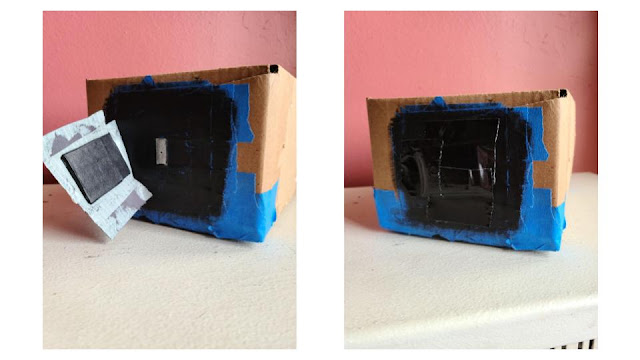It's a Box! It's a Camera?
This is an action project for my core class Light, Sound, & Time. In this first unit, we learned about light and how it works. I learned a lot about wave-particle duality, the visible spectrum, the electromagnetic spectrum, human eyes, and similar triangles. A couple of students went on an FE to the GCE building to use the darkroom that our teacher set up. For this project, we were asked to build our own pinhole camera to show how we could use light to capture images.
CH. "Pinhole Camera." 2021
I believe that my camera uses reflection and not refraction in order to capture pictures. When light hits an object or the subject that I am taking a picture of, the light will then reflect off of the object/subject in the form of color. Refraction is the bending of light when it passes through one transparent substance to another. Reflection is when light bounces off an object at the same angle it hit it. When white light enters the earth's atmosphere, that white light filters out to contain seven different colors. Those seven colors are the colors of the rainbow. When the now colored light hits an object, that object will absorb any of the seven colors that do not match up with that object and turn that light into energy. The colored light that matches with that object will reflect off back to the camera for the picture.
CH. "Similar Triangles." 2021
Using the Pythagorean theorem, I can calculate the hypotenuse of each triangle: 2.5^2 + 8.4^2 =H1^2 , so H1 = 8.76, and (30.24 + 8.4)^2 + 11.5^2 = H2^2, so H2 = 40.32. 40.32 - 8.76 = 31.56. I can also use tan^-1 of (2.5/8.4) to find the angle of the light hitting the back corner of my camera, which is 16.57*(degrees). Since these are right triangles, the other angle is 180* - 90* - 16.57* = 73.43*.
The first picture that I took was completely white once we developed it. This meant that it received no light at all. I think this happened because the picture was taken inside. I expected the image to come up with some light, so I was surprised when the picture came up blank. The picture was taken in an area with only one lamp and the area was poorly lit, so this could explain why the picture received no light. The picture was taken with a shutter speed of 7 minutes. The second picture was taken outside. This picture was a bit overexposed, but you can make out shapes in the picture. I took this picture in a shaded area facing a glass/shiny building. The picture was taken with a shutter speed of 5 minutes.
CH. "Pinhole Photographs." 2021
This was one of my favorite AP's. I love cameras and have actually done my own independent study surrounding photography. I would definitely consider using the darkroom at GCE again or setting up my own at home. If I had to change anything, I would definitely have spent more time trying to get the "perfect" shutter time for my desired photo. I hope you enjoyed my AP!





Comments
Post a Comment